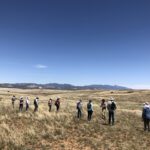Sep 15, 2016 | Blog
By Jenny Neeley, Attorney at Law
Introduction: National Environmental Policy Act & Scoping Process
The National Environmental Policy Act (NEPA) requires all federal agencies to prepare a “detailed statement” on the impacts of any proposed action that may “significantly affect the quality of the human environment.”¹ This “detailed statement” can take one of two forms:
- Environmental Assessment (EA), a brief analysis used to determine the significance of impacts resulting from a federal action, or
- Environmental Impact Statement (EIS), a detailed and thorough analysis used for those actions that are expected to result in significant impacts.
Federal agencies are required to go through a public “scoping process” in order to determine the scope of issues that should be addressed in an EA or EIS. Scoping also helps the agency determine the likely significance of an action’s impacts, and whether an EA or an EIS will be required.
What to Include in NEPA Scoping Comments
The scoping period is the best time to identify all the issues and resources that the agency must consider when preparing an EA or EIS, as well as the potential impacts the proposed action may have on those resources.
Identify resources likely to be impacted.
This includes all the resources and values that are likely to be impacted by the proposed action, including:
- Air quality
- Water quality and quantity
- Wildlife and vegetation, including endangered, threatened, and other special status species
- Wildlife movement corridors
- Soils
- Watersheds Floodplains, wetlands, and riparian areas
- Cultural and Archeological resources
- Visual resources and scenic values
- Dark skies
- Recreation
- Transportation and traffic
- Public safety
- Socioeconomic Impacts
Identify potential impacts resulting from proposed action.
The scoping period is also the best time to identify all the potential impacts that are likely to result from the proposed action. The potential impacts will vary depending on the specific activity being proposed, and can include ecological, aesthetic, historic, cultural, economic, social, and health related impacts. When assessing potential impacts, the agency must look at:
- Direct impacts: “are caused by the action and occur at the same time and place;”
- Indirect impacts: “are caused by the action and are later in time or farther removed in distance, but are still reasonably foreseeable (e.g., induced changes in land use patterns, population density, and related effects on natural resources and ecosystems);” and
- Cumulative impacts: “the impact on the environment which results from the incremental impact of the action when added to other past, present, and reasonably foreseeable future actions, regardless of what agency or person undertakes such actions. Cumulative impacts can result from individually minor but collectively significant actions taking place over a period of time.” ²
REMEMBER: You don’t have to do the analysis for the agency. At the scoping stage, you just need to identify the issues and potential impacts that must be analyzed. You should also submit any research or supporting documentation that is relevant to assessing the significance of the project’s potential impacts. The agency is obligated to consider this material when drafting the EA or EIS.
Act Now: Hermosa-Taylor Deposit Drilling Project Scoping Notice and Plan of Operation.
———————————–
1 National Environmental Policy Act (NEPA), 42 USC § 4332(C) (1982).
2 Council for Environmental Quality, NEPA Implementing Regulations, 40 CFR § 1508.8 (2010).
Mar 27, 2014 | Blog
Tips for Writing Comments for a Draft EA
By Jenny Neeley
1. Consider whether the effects significant. If they are, then the Forest Service must prepare a more detailed Environmental Impact Statement (EIS) rather than an Environmental Assessment (EA). When deciding whether the impacts are “significant” NEPA implementing regulations (40 CFR § 1508.27) require that agencies consider both:
- Context: The significance of an action must be analyzed in several contexts such as society as a whole, the affected region, the affected interests, and the locality. Significance varies with the setting of the proposed action. For instance, in the case of a site-specific action, significance would usually depend upon the effects in the locale rather than in the world as a whole. Both short- and long-term effects are relevant.
- Intensity: This refers to the severity of impact. …The following should be considered in evaluating intensity:
- Impacts that may be both beneficial and adverse. A significant effect may exist even if the Federal agency believes that on balance the effect will be beneficial.
- The degree to which the proposed action affects public health or safety.
- Unique characteristics of the geographic area such as proximity to historic or cultural resources, park lands, prime farmlands, wetlands, wild and scenic rivers, or ecologically critical areas.
- The degree to which the effects on the quality of the human environment are likely to be highly controversial.
- The degree to which the possible effects on the human environment are highly uncertain or involve unique or unknown risks.
- The degree to which the action may establish a precedent for future actions with significant effects or represents a decision in principle about a future consideration.
- Whether the action is related to other actions with individually insignificant but cumulatively significant impacts. Significance exists if it is reasonable to anticipate a cumulatively significant impact on the environment. Significance cannot be avoided by terming an action temporary or by breaking it down into small component parts.
- The degree to which the action may adversely affect districts, sites, highways, structures, or objects listed in or eligible for listing in the National Register of Historic Places or may cause loss or destruction of significant scientific, cultural, or historical resources.
- The degree to which the action may adversely affect an endangered or threatened species or its habitat that has been determined to be critical under the Endangered Species Act of 1973.
- Whether the action threatens a violation of Federal, State, or local law or requirements imposed for the protection of the environment.
2. Make your comments “substantive” and specific. The Forest Service is required by law to respond to all “substantive” comments submitted during the public comment period; the more specific and focused your comments are, the more detailed the response must be from the agency. Comments that simply say “I am opposed to this project” will not, by themselves, require a response from the agency.
3. Include the specific sections, pages and/or topics you are referencing in the Draft EA. To the extent you can, direct your comments to specific sections, pages or topics in the Draft EA, recognizing that some comments may be addressing missing or incomplete information, or even missing topics, that you feel should be addressed.
4. Make your letter personal! Your personal connection to the Patagonia Mountains and surrounding area is an incredibly important part of your comment letter. You should explain how will you be personally impacted if this proposal moves forward. Include information about how it will affect your home, your land, your family, and/or your business and livelihood. This is a great way to start your letter and to frame the rest of your comments, and will help get the Forest Service’s attention.
Additional Information
See our NEPA Resources page: http://www.patagoniaalliance.org/nepa-resources/
More information about Wildcat Silver at: http://www.patagoniaalliance.org/wildcat-silver/









